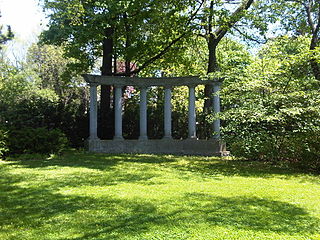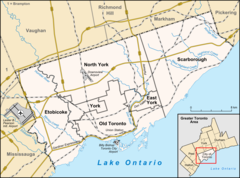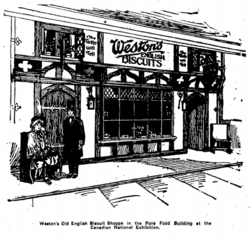Marilyn Grace Bell Di Lascio is a Canadian retired long distance swimmer. She was the first person to swim across Lake Ontario and later swam the English Channel and Strait of Juan de Fuca.
Loblaws is a Canadian supermarket chain with stores located in the province of Ontario, and in Alberta and British Columbia under the Loblaws CityMarket banner. Headquartered in Brampton, Ontario, Loblaws is a subsidiary of Loblaw Companies Limited, Canada's largest food distributor.

Loblaw Companies Limited is a Canadian retailer encompassing corporate and franchise supermarkets operating under 22 regional and market-segment banners, as well as pharmacies, banking and apparel. Loblaw operates a private label program that includes grocery and household items, clothing, baby products, pharmaceuticals, cellular phones, general merchandise and financial services. Loblaw is the largest Canadian food retailer, and its brands include President's Choice, No Name and Joe Fresh. It is controlled by George Weston Limited, a holding company controlled by the Weston family; Galen G. Weston is the chair of the Loblaw board of directors, as well as chair of the board of directors and CEO of Canada-based holding company George Weston.
Dominion was a national chain of supermarkets in Canada, which was known as the Dominion of Canada when the chain was founded. The chain was founded in 1919 in Ontario and was later acquired by the Argus Corporation. It was later sold to The Great Atlantic & Pacific Tea Company (A&P), which restricted the chain to the Greater Toronto Area. Stores outside Ontario were converted to the A&P banner or sold to third parties. A&P's Canadian division was later acquired by Metro Inc., which rebranded the remaining Dominion stores to its namesake banner in 2008.

The Canadian National Exhibition (CNE), also known as The Exhibition or The Ex, is an annual event that takes place at Exhibition Place in Toronto, Ontario, Canada, on the third Friday of August leading up to and including Labour Day, the first Monday in September. With approximately 1.6 million visitors each year, the CNE is Canada's largest annual community event and one of the top fairs in North America. The fair is a combination of agricultural exhibits and events, carnival rides and entertainment, live music, food and special events. Special events include the Warriors Day Parade, the Labour Day Parade and the Canadian International Air Show.

New Toronto is a neighbourhood and former municipality in Toronto, Ontario, Canada. It is located in the south-west area of Toronto, along Lake Ontario. The Town of New Toronto was established in 1890, and was designed and planned as an industrial centre by a group of industrialists from Toronto who had visited Rochester, New York. New Toronto was originally a part of the Township of Etobicoke. It was an independent municipality from 1913 to 1967, being one of the former 'Lakeshore Municipalities' amalgamated into the Borough of Etobicoke, and eventually amalgamated into Toronto. The neighbourhood has retained the name.

Exhibition Place is a publicly owned mixed-use district in Toronto, Ontario, Canada, located by the shoreline of Lake Ontario, just west of downtown. The 197-acre (80 ha) site includes exhibit, trade, and banquet centres, theatre and music buildings, monuments, parkland, sports facilities, and a number of civic, provincial, and national historic sites. The district's facilities are used year-round for exhibitions, trade shows, public and private functions, and sporting events.

Canadian National Exhibition Stadium was a multi-purpose stadium in Toronto, Ontario, Canada, on the grounds of Exhibition Place. Originally built for Canadian National Exhibition events, the stadium served as the home of the Toronto Argonauts of the Canadian Football League (CFL) from 1959 to 1988, the Toronto Blue Jays of Major League Baseball (MLB) from 1977 to 1989, and the Toronto Blizzard of the North American Soccer League (NASL) from 1979 to 1983. The stadium hosted the Grey Cup game 12 times over a 24-year period.

The Royal Agricultural Winter Fair (RAWF), also known as The Royal, is an annual agricultural fair that is held in Toronto, Ontario, Canada during the first two weeks of November. It was inaugurated in 1922 in the Coliseum, on the grounds of Exhibition Place. It has since been expanded to also take up the Enercare Centre and remains an important exhibit for livestock breeders. Elizabeth II, as Queen of Canada, was the fair's royal patron. Members of the Canadian Royal Family have also been guests of honour at the fair. It is the largest indoor agricultural fair in the world.

New Fort York, later the Stanley Barracks, is a former British and Canadian military base in Toronto, Ontario, Canada, located on the Lake Ontario shoreline. It was built in 1840–1841 to replace Toronto's original Fort York at the mouth of Garrison Creek as the primary military base for the settlement. Unlike the older fort, many of the new fort buildings were made with limestone instead of wood. A protective wall was planned for the new fort but was never built. The fort was used by the British army until 1870, and the Canadian military subsequently used the fort to train troops for the Second Boer War, World War I and World War II. It also trained one of the first regiments of the North-West Mounted Police. The Canadian military stopped using it after World War II and the fort was demolished in the 1950s. Only the Officers' Quarters building remains on the site.

Coca-Cola Coliseum is an arena at Exhibition Place in Toronto, Ontario, Canada, used for agricultural displays, ice hockey, and trade shows. It was built for the Canadian National Exhibition (CNE) and the Royal Agricultural Winter Fair in 1921. Since 1997 it has been part of the Enercare Centre exhibition complex. It serves as the home arena of the Toronto Marlies ice hockey team, the American Hockey League farm team of the Toronto Maple Leafs. For the 2015 Pan American Games the venue hosted the gymnastics competitions and was known as the Toronto Coliseum.

The Automotive Building is a heritage building at Exhibition Place in Toronto, Ontario, Canada, containing event and conference space. In the 1920s, as a result of burgeoning interest in automobiles, additional exhibition space for automotive exhibits during the annual Canadian National Exhibition (CNE) was needed. A design competition was held, and the winning design was submitted by Toronto architect Douglas Kertland. The building opened in 1929, and the "National Motor Show" exhibit of automobiles was held in the building until 1967. It was also used for trade shows. When it opened, it was claimed to be "the largest structure in North America designed exclusively to display passenger vehicles". During World War II, the building was used by the Royal Canadian Navy and named HMCS York. After the end of automotive exhibits at the CNE, the building was used for other CNE exhibits and continued to be used for trade shows.

The Horse Palace is a heritage building at Exhibition Place in Toronto, Ontario, Canada, containing stables, a horse ring and various agencies. It was constructed to support the equestrian events of the Royal Agricultural Winter Fair. The ornamentation of the building is considered a fine example of Art Deco. It is a listed heritage building.

The CNE Bandshell is an open-air concert venue in Toronto, Ontario, Canada. It is located at Exhibition Place on the shores of Lake Ontario. Built in 1936, it hosts the annual music program of the Canadian National Exhibition (CNE) and is also used for festivals and picnic events, for which the "Bandshell Park" can be rented from the City of Toronto.
George Weston Limited, often referred to as Weston or Weston's, is a Canadian holding company. Founded by George Weston in 1882, the company today consists of the Choice Properties real estate investment trust and Loblaw Companies Limited, Canada's largest supermarket retailer, in which it maintains a controlling interest. Retail brands include President's Choice, No Name and Joe Fresh. The former Weston Bakeries division, which owned the brands Wonder, Country Harvest, D'Italiano, Ready Bake and Gadoua, was sold off to FGF Brands in 2022. The company is controlled by the Weston family, which owns a majority share in George Weston Limited.

Willard Garfield Weston was a Canadian businessman and philanthropist who was a member of the prominent Weston family. He led George Weston Limited and its various subsidiaries and associated companies, including Associated British Foods, for half a century and established one of the world's largest food processing and distribution concerns. He also served as a Member of Parliament (MP) in the British House of Commons during World War II.

Enercare Centre, formerly known as the Direct Energy Centre and originally the National Trade Centre, is an exhibition complex located at Exhibition Place in Toronto, Ontario, Canada. It is used by the Canadian National Exhibition and the Royal Agricultural Winter Fair, as well as by various trade shows. In 2015, it hosted several sport competitions and the broadcasting centre for the 2015 Pan American Games.

The Princes' Gates is a triumphal arch and a monumental gateway at Exhibition Place in Toronto, Ontario, Canada. Made out of cement and stone, the triumphal arch is flanked by colonnades on both of its sides, with curved pylons at both ends. The 350-foot-long (110 m) structure serves as the eastern gateway to the Canadian National Exhibition, an annual agricultural and provincial fair held at Exhibition Place.

Hotel X Toronto is a hotel and sports club complex on the grounds of Exhibition Place in Toronto, Ontario, Canada. The hotel, part of the Library Hotel Collection, is intended to serve visitors attending conventions, meetings, and trade shows booked at the adjacent Enercare Centre and the Beanfield Centre. Hotel X Toronto is divided into three parts: the hotel tower, the Ten X Toronto (10XTO) athletic facility and the historic Stanley Barracks Officers' Quarters and foundations.
David Bednar is an American-born former theatre manager in Canada. He served as the general manager of the Canadian National Exhibition Association, which runs an annual fair called the Canadian National Exhibition (CNE). He retired in May 2015.

















